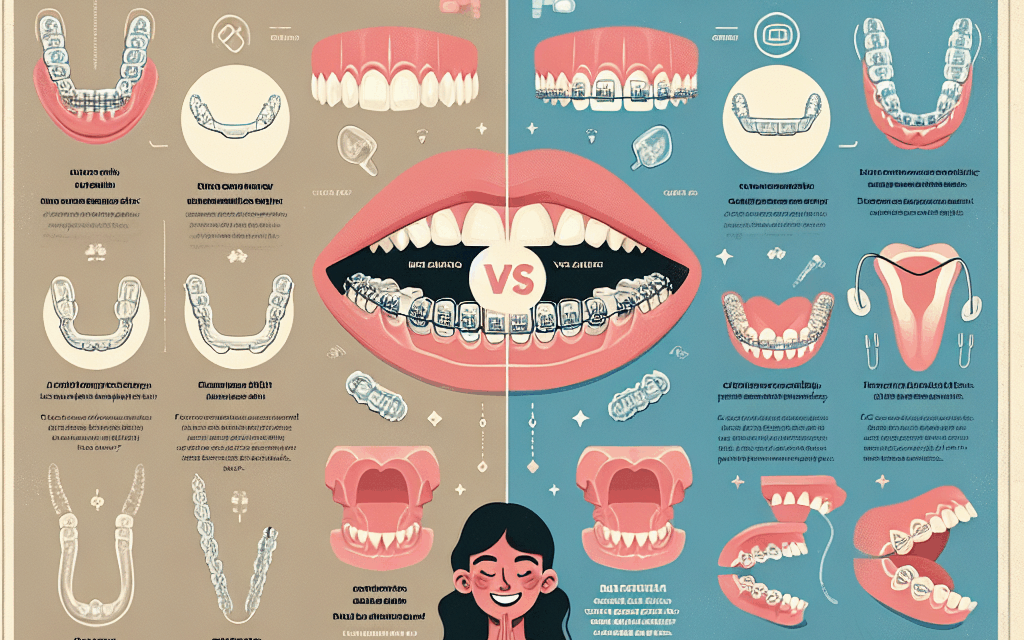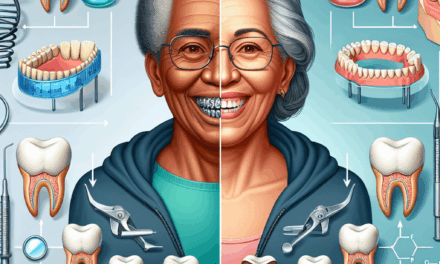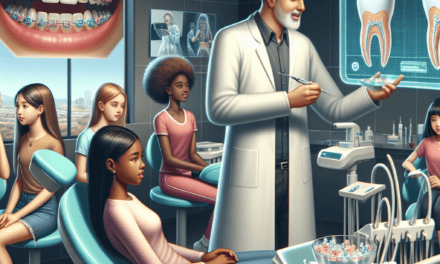Clear Braces vs. Invisalign: Which is Right for You?
In the world of orthodontics, the quest for a perfect smile has led to the development of various teeth-straightening options. Among these, clear braces and Invisalign have emerged as popular choices for individuals seeking a more discreet alternative to traditional metal braces. But how do these two options compare? This article will delve into the nuances of clear braces and Invisalign, helping you determine which option is best suited for your orthodontic needs.
Understanding Clear Braces
Clear braces, often referred to as ceramic braces, are a type of fixed orthodontic appliance that uses clear or tooth-colored brackets and wires. They function similarly to traditional metal braces but are designed to be less noticeable. Here’s a closer look at their features, benefits, and drawbacks.
1. Features of Clear Braces
Clear braces are designed to blend in with the natural color of your teeth, making them a more aesthetically pleasing option compared to traditional metal braces. Here are some key features:
- Material: Clear braces are typically made from ceramic or composite materials that are less visible than metal.
- Brackets and Wires: The brackets are bonded to the teeth and connected by a wire, which is adjusted periodically by the orthodontist.
- Durability: While they are less durable than metal braces, advancements in materials have improved their strength.
2. Benefits of Clear Braces
Clear braces offer several advantages that make them an appealing choice for many patients:
- Aesthetic Appeal: The clear or tooth-colored brackets are less noticeable, making them a popular choice for adults and teens.
- Effective Treatment: Clear braces can effectively treat a wide range of orthodontic issues, including severe misalignment.
- Customizable Options: Some clear braces allow for customization in terms of color and design, adding a personal touch.
3. Drawbacks of Clear Braces
Despite their benefits, clear braces also come with some disadvantages:
- Staining: The ceramic material can stain over time, especially if patients consume certain foods and beverages.
- Comfort: Clear braces may cause more discomfort than Invisalign, as they are fixed appliances that can irritate the gums.
- Longer Treatment Time: Treatment with clear braces may take longer than with Invisalign, depending on the complexity of the case.
4. Treatment Process with Clear Braces
The treatment process with clear braces typically involves several steps:
- Initial Consultation: The orthodontist will assess your teeth and create a treatment plan tailored to your needs.
- Placement: The brackets are bonded to your teeth, and the wire is threaded through them.
- Regular Adjustments: You will need to visit the orthodontist every 4-6 weeks for adjustments and monitoring.
- Retention: After the braces are removed, a retainer will be provided to maintain your new smile.
5. Cost of Clear Braces
The cost of clear braces can vary significantly based on several factors:
- Location: Prices can differ based on geographic location and the cost of living.
- Orthodontist’s Experience: More experienced orthodontists may charge higher fees.
- Insurance Coverage: Some dental insurance plans may cover a portion of the cost.
On average, clear braces can range from $3,000 to $8,000, depending on the complexity of the case and the duration of treatment.
Exploring Invisalign
Invisalign is a revolutionary orthodontic treatment that uses a series of clear, removable aligners to gradually shift teeth into their desired positions. This method has gained immense popularity due to its convenience and aesthetic appeal. Let’s explore the features, benefits, and drawbacks of Invisalign.
1. Features of Invisalign
Invisalign aligners are custom-made for each patient using advanced 3D imaging technology. Here are some defining features:
- Custom Fit: Each aligner is tailored to fit snugly over your teeth, ensuring comfort and effectiveness.
- Removable: Aligners can be easily removed for eating, brushing, and flossing, promoting better oral hygiene.
- Progressive Treatment: Patients receive a series of aligners, each designed to move teeth incrementally over time.
2. Benefits of Invisalign
Invisalign offers numerous advantages that appeal to a wide range of patients:
- Discreet Appearance: The clear aligners are virtually invisible, making them an excellent choice for adults and teens who prefer a subtle treatment option.
- Comfort: The smooth plastic material is less likely to irritate gums and cheeks compared to traditional braces.
- Convenience: The ability to remove aligners allows for easier eating and oral hygiene practices.
3. Drawbacks of Invisalign
While Invisalign has many benefits, it also has some limitations:
- Compliance Required: Patients must wear aligners for 20-22 hours a day for effective treatment, which requires discipline.
- Not Suitable for All Cases: Invisalign may not be the best option for complex orthodontic issues that require more precise movements.
- Cost: Invisalign can be more expensive than traditional braces, with costs ranging from $3,000 to $8,000.
4. Treatment Process with Invisalign
The treatment process for Invisalign involves several key steps:
- Initial Consultation: The orthodontist will evaluate your teeth and determine if Invisalign is suitable for you.
- 3D Imaging: Advanced imaging technology is used to create a digital model of your teeth, which is used to design your custom aligners.
- Receiving Aligners: You will receive a series of aligners, each to be worn for about two weeks before progressing to the next set.
- Regular Check-ups: Follow-up appointments are scheduled every 6-8 weeks to monitor progress and make adjustments as needed.
- Retention: After completing the treatment, a retainer will be provided to maintain your new smile.
5. Cost of Invisalign
The cost of Invisalign can vary based on several factors:
- Complexity of Treatment: More complex cases may require additional aligners, increasing the overall cost.
- Geographic Location: Prices can differ based on the cost of living in your area.
- Insurance Coverage: Some dental insurance plans may cover a portion of the cost, similar to traditional braces.
On average, Invisalign treatment can range from $3,000 to $8,000, depending on the specific needs of the patient.
Comparative Analysis: Clear Braces vs. Invisalign
When deciding between clear braces and Invisalign, it’s essential to consider various factors that can influence your choice. Here’s a comparative analysis of both options:
1. Aesthetic Considerations
Aesthetics play a significant role in the decision-making process for many patients. Clear braces are less noticeable than traditional metal braces but are still fixed appliances. In contrast, Invisalign aligners are virtually invisible, making them the preferred choice for those who prioritize discretion.
2. Treatment Effectiveness
Both clear braces and Invisalign are effective in treating a range of orthodontic issues. However, clear braces may be more suitable for complex cases that require precise tooth movements. Invisalign is effective for mild to moderate cases but may not be the best option for severe misalignments.
3. Comfort and Convenience
Invisalign aligners are generally more comfortable than clear braces, as they do not have brackets or wires that can irritate the mouth. Additionally, the ability to remove aligners for eating and cleaning makes Invisalign more convenient for many patients. Clear braces, being fixed, require more effort in terms of oral hygiene and dietary restrictions.
4. Treatment Duration
The duration of treatment can vary based on individual cases. Generally, Invisalign treatment may be quicker for mild to moderate cases, while clear braces may take longer for complex issues. Regular adjustments are required for clear braces, which can extend the treatment timeline.
5. Cost Considerations
Both clear braces and Invisalign can be similarly priced, with costs ranging from $3,000 to $8,000. However, the final cost will depend on factors such as the complexity of the case, geographic location, and insurance coverage. It’s essential to discuss payment options and insurance benefits with your orthodontist.
Case Studies and Real-Life Examples
To provide further insight into the effectiveness of clear braces and Invisalign, let’s explore some real-life case studies and examples:
1. Case Study: Clear Braces
A 25-year-old female patient presented with moderate crowding and misalignment of her upper and lower teeth. After a thorough evaluation, her orthodontist recommended clear braces. The treatment plan involved placing clear ceramic brackets on her teeth, with regular adjustments every six weeks. After 18 months of treatment, the patient achieved a beautifully aligned smile, with minimal staining on the brackets. The patient reported satisfaction with the aesthetic appeal of the clear braces and appreciated the effectiveness in addressing her orthodontic concerns.
2. Case Study: Invisalign
A 30-year-old male patient sought orthodontic treatment for mild spacing issues and a slight overbite. After discussing his options, he opted for Invisalign due to its discreet nature and convenience. The orthodontist created a series of custom aligners using 3D imaging technology. The patient wore each aligner for two weeks and attended follow-up appointments every eight weeks. After 12 months, he achieved his desired results with a straightened smile and improved bite. The patient expressed satisfaction with the comfort and ease of maintaining oral hygiene during treatment.
3. Comparative Case Study
A 16-year-old female patient had a severe overbite and crowding. After consultation, her orthodontist recommended clear braces due to the complexity of her case. The treatment involved the use of clear ceramic brackets and wires. After 24 months of treatment, the patient achieved significant improvement in her bite and alignment. In contrast, a peer with similar issues opted for Invisalign but faced challenges with compliance, leading to a longer treatment duration. This case highlights the importance of individual needs and compliance in determining the best treatment option.
Conclusion: Making the Right Choice for You
Choosing between clear braces and Invisalign ultimately depends on your individual orthodontic needs, lifestyle, and preferences. Both options offer unique benefits and drawbacks, making it essential to consult with an experienced orthodontist who can guide you through the decision-making process.
In summary, here are the key takeaways:
- Clear Braces: Aesthetic, effective for complex cases, but may cause discomfort and require more maintenance.
- Invisalign: Discreet, comfortable, and convenient, but requires compliance and may not be suitable for severe cases.
- Consultation is Key: An orthodontist can provide personalized recommendations based on your specific needs and goals.
Ultimately, both clear braces and Invisalign can help you achieve the smile you’ve always wanted. By weighing the pros and cons of each option and considering your lifestyle, you can make an informed decision that aligns with your orthodontic goals.





